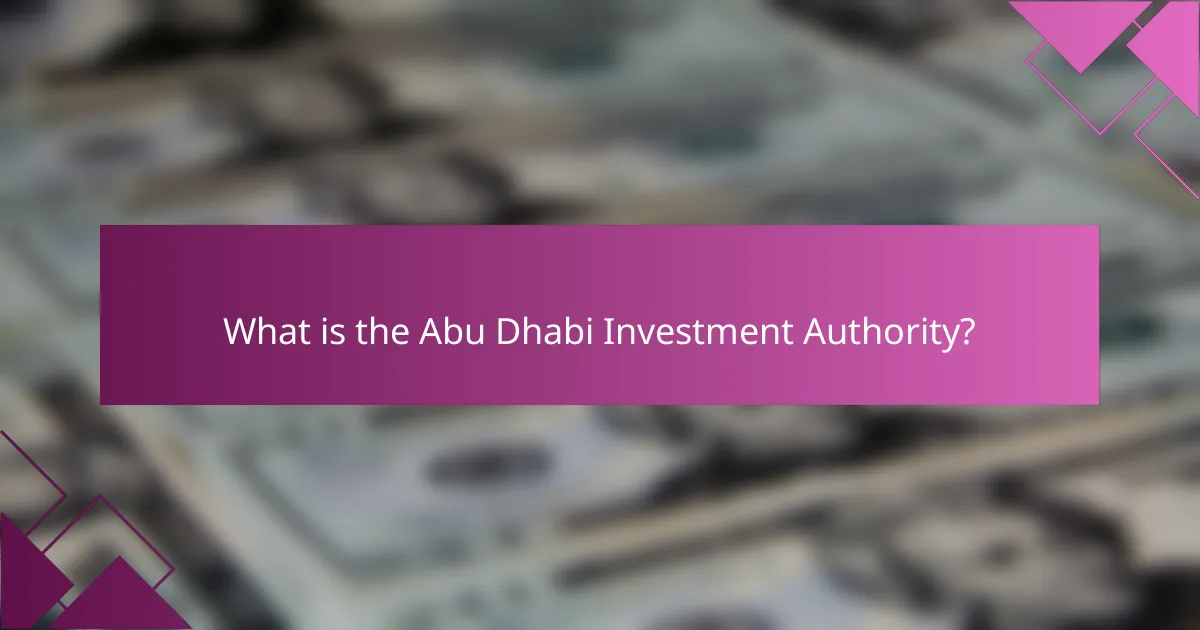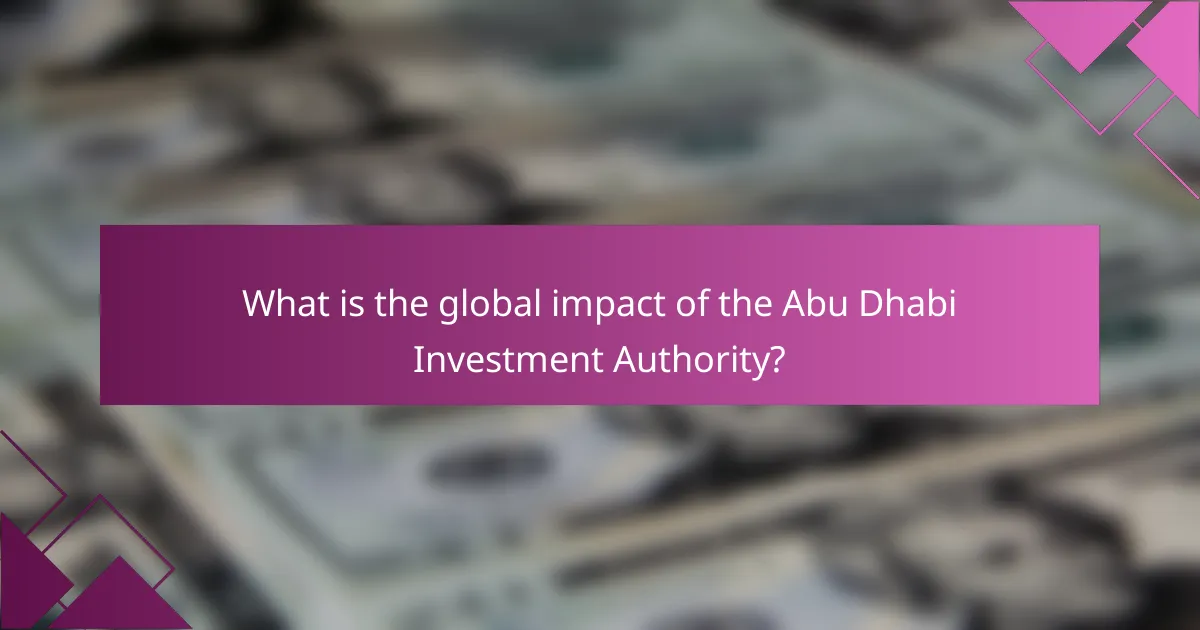
What is the Abu Dhabi Investment Authority?
The Abu Dhabi Investment Authority (ADIA) is a sovereign wealth fund owned by the Emirate of Abu Dhabi. Established in 1976, ADIA is one of the largest investment funds in the world. It manages a diverse portfolio of assets across various sectors. These sectors include equities, fixed income, real estate, and alternative investments. As of 2023, ADIA’s assets are estimated to be over $700 billion. The fund aims to generate sustainable long-term returns for the Emirate of Abu Dhabi. ADIA plays a significant role in global financial markets. Its investment strategies focus on diversification and risk management.
How was the Abu Dhabi Investment Authority established?
The Abu Dhabi Investment Authority was established in 1976. It was created to manage the emirate’s surplus oil revenues. The authority was founded by Sheikh Zayed bin Sultan Al Nahyan, the founding father of the United Arab Emirates. Its primary goal was to invest and diversify the emirate’s wealth. Initially, the authority focused on domestic investments. Over time, it expanded its portfolio globally. The Abu Dhabi Investment Authority has since become one of the world’s largest sovereign wealth funds. It now manages assets worth hundreds of billions of dollars.
What were the initial goals of the Abu Dhabi Investment Authority?
The initial goals of the Abu Dhabi Investment Authority (ADIA) were to invest surplus oil revenues for the long-term benefit of Abu Dhabi. Established in 1976, ADIA aimed to diversify the emirate’s economy beyond oil dependency. The authority sought to generate sustainable financial returns. It focused on preserving the wealth of future generations. ADIA also aimed to enhance the emirate’s economic stability. By investing globally, ADIA intended to mitigate risks associated with oil price volatility. These goals were foundational to its investment strategy and operational framework.
Who were the key figures in the formation of the Abu Dhabi Investment Authority?
Sheikh Zayed bin Sultan Al Nahyan and Sheikh Khalifa bin Zayed Al Nahyan were key figures in the formation of the Abu Dhabi Investment Authority (ADIA). Sheikh Zayed, the founding father of the United Arab Emirates, established ADIA in 1976. His vision was to manage the emirate’s oil revenues effectively for future generations. Sheikh Khalifa, his son, played a significant role in the authority’s strategic direction and growth. Under their leadership, ADIA became one of the largest sovereign wealth funds globally, focusing on diversified investments.
What is the historical growth of the Abu Dhabi Investment Authority?
The Abu Dhabi Investment Authority (ADIA) has experienced significant historical growth since its establishment in 1976. Initially, ADIA was created to invest the emirate’s surplus oil revenues. Over the decades, it has expanded its asset base through diversification into various sectors. By 2022, ADIA’s total assets were estimated to exceed $700 billion. This growth has been driven by strategic investments in public and private markets globally. The authority has also focused on sustainable and innovative investment strategies. ADIA’s commitment to transparency and governance has enhanced its reputation in the investment community. Its historical performance reflects a consistent focus on long-term value creation.
How has the asset base of the Abu Dhabi Investment Authority evolved over time?
The asset base of the Abu Dhabi Investment Authority (ADIA) has significantly grown over time. Established in 1976, ADIA’s initial capital was approximately $1 billion. By 2020, the total assets under management reached around $696 billion. This growth is attributed to strategic investments across various asset classes, including equities, fixed income, real estate, and alternatives. ADIA has consistently focused on diversification to mitigate risks and enhance returns. The authority has expanded its global footprint, investing in over 50 countries. This evolution reflects ADIA’s adaptive strategies in response to changing market conditions and economic trends.
What key milestones mark the development of the Abu Dhabi Investment Authority?
The Abu Dhabi Investment Authority (ADIA) was established in 1976. It was created to manage the emirate’s surplus oil revenues. In 1980, ADIA began investing internationally. By the 1990s, ADIA expanded its investment portfolio significantly. In 2008, it faced challenges during the global financial crisis but remained resilient. ADIA’s assets reached approximately $700 billion by 2021. In recent years, ADIA has emphasized sustainable investing. It continues to adapt its strategies to global market changes.

How does the Abu Dhabi Investment Authority allocate assets?
The Abu Dhabi Investment Authority allocates assets through a diversified investment strategy. This strategy includes a mix of equities, fixed income, real estate, and alternative investments. The authority aims to achieve long-term capital appreciation and sustainable returns. It employs a global approach, investing in various markets and sectors. The asset allocation is regularly reviewed to adapt to market conditions. In 2022, approximately 60% of its portfolio was allocated to equities and fixed income. The remaining 40% was invested in real estate and alternatives. This balanced approach helps mitigate risks and optimize returns.
What are the primary asset classes in the Abu Dhabi Investment Authority’s portfolio?
The primary asset classes in the Abu Dhabi Investment Authority’s portfolio include equities, fixed income, real estate, and infrastructure. Equities represent a significant portion, focusing on both developed and emerging markets. Fixed income investments cover government and corporate bonds. Real estate investments span various sectors, including commercial and residential properties. Infrastructure assets focus on energy, transport, and utilities. This diversified allocation aims to achieve long-term growth and stability in the portfolio.
How does the Abu Dhabi Investment Authority diversify its investments?
The Abu Dhabi Investment Authority diversifies its investments through a multi-asset strategy. This includes investing in equities, fixed income, real estate, and alternative assets. The authority allocates funds across various geographic regions. It also focuses on different sectors to mitigate risks. The investment approach emphasizes long-term growth. The authority employs a rigorous risk management framework. This framework assesses market conditions and investment performance. By diversifying, the Abu Dhabi Investment Authority aims to achieve stable returns over time.
What strategies does the Abu Dhabi Investment Authority employ for risk management?
The Abu Dhabi Investment Authority employs a diversified investment strategy for risk management. This approach includes asset allocation across various sectors and geographies. The Authority utilizes quantitative models to assess risk exposure. It also conducts thorough due diligence before investment decisions. Regular portfolio reviews are integral to its risk management process. The Authority engages in stress testing to evaluate potential impacts of market volatility. Furthermore, it emphasizes liquidity management to ensure operational stability. These strategies collectively help mitigate risks and enhance overall portfolio performance.
How does the Abu Dhabi Investment Authority approach international investments?
The Abu Dhabi Investment Authority (ADIA) approaches international investments through a diversified strategy. This strategy emphasizes asset allocation across various sectors and geographies. ADIA invests in public equities, fixed income, real estate, and alternative investments. The authority seeks to achieve long-term growth while managing risk. It utilizes a research-driven approach to identify opportunities. ADIA collaborates with global partners to enhance its investment capabilities. The authority also focuses on sustainability and responsible investing practices. This approach aligns with its goal of generating sustainable returns for future generations.
What regions does the Abu Dhabi Investment Authority focus on for global investments?
The Abu Dhabi Investment Authority focuses on multiple regions for global investments. These include North America, Europe, Asia, and the Middle East. The authority strategically allocates assets across these regions to diversify its investment portfolio. In North America, it targets sectors like technology and real estate. In Europe, investments often focus on infrastructure and energy. Asia presents opportunities in emerging markets and consumer sectors. The Middle East investments are typically centered on local and regional developments. This regional focus allows the authority to leverage growth potential in various markets.
How does the Abu Dhabi Investment Authority assess potential international opportunities?
The Abu Dhabi Investment Authority assesses potential international opportunities through a comprehensive evaluation framework. This framework includes rigorous market analysis, financial modeling, and risk assessment. The authority prioritizes sectors with high growth potential and favorable economic conditions. It also considers geopolitical stability and regulatory environments in target markets. The evaluation process involves collaboration with local partners and industry experts. This approach ensures informed decision-making and alignment with strategic objectives. The authority’s historical performance and investment track record further guide its assessment criteria.

What is the global impact of the Abu Dhabi Investment Authority?
The Abu Dhabi Investment Authority (ADIA) has a significant global impact as one of the largest sovereign wealth funds in the world. It manages assets estimated at over $700 billion. ADIA invests across various asset classes, including equities, fixed income, real estate, and alternatives. Its investments span multiple countries and sectors, influencing global financial markets.
ADIA’s presence in international markets promotes economic stability and growth. The fund supports infrastructure projects and sustainable development initiatives worldwide. In recent years, ADIA has focused on technology and renewable energy investments. This shift aligns with global trends towards sustainability and innovation.
The authority’s investment strategies contribute to job creation and economic diversification in host countries. ADIA’s reputation as a long-term investor attracts other institutional investors. This collaboration fosters economic partnerships and enhances global trade relations. Overall, ADIA’s strategic investments play a vital role in shaping the global economy.
How does the Abu Dhabi Investment Authority influence global markets?
The Abu Dhabi Investment Authority (ADIA) influences global markets through its substantial investment portfolio. ADIA manages over $700 billion in assets, making it one of the largest sovereign wealth funds worldwide. Its investment strategies include diversifying across various asset classes, including equities, fixed income, real estate, and alternative investments. By investing in international markets, ADIA impacts stock prices and market liquidity.
ADIA’s investments often signal confidence in specific sectors or regions. For example, its significant stakes in technology companies can drive market interest and investment in that sector. The authority also engages in long-term partnerships with global firms, enhancing its influence on corporate governance and strategic direction. Its presence in emerging markets contributes to economic development and stability.
In 2020, ADIA invested in companies like Uber and Alibaba, demonstrating its role in shaping market trends. The fund’s decisions can lead to increased capital flows into targeted markets, affecting currency values and investment climates. Overall, ADIA’s strategic investments position it as a key player in global financial markets.
What role does the Abu Dhabi Investment Authority play in sustainable investing?
The Abu Dhabi Investment Authority (ADIA) plays a significant role in sustainable investing by integrating environmental, social, and governance (ESG) factors into its investment strategies. ADIA aims to enhance long-term value while supporting sustainable economic growth. The authority actively invests in renewable energy projects and sustainable infrastructure globally. For instance, ADIA committed $1 billion to the Green Climate Fund to support climate change mitigation efforts. Additionally, ADIA collaborates with other institutional investors to promote responsible investment practices. This collaborative approach amplifies the impact of sustainable investing initiatives across various sectors. Through these efforts, ADIA demonstrates its commitment to sustainability and responsible investment.
How does the Abu Dhabi Investment Authority contribute to economic development in various regions?
The Abu Dhabi Investment Authority (ADIA) contributes to economic development in various regions through strategic investments. ADIA allocates capital across diverse asset classes globally. This investment strategy supports job creation and infrastructure development. ADIA invests in sectors such as real estate, technology, and energy. These investments stimulate local economies and foster innovation. In 2020, ADIA managed assets worth approximately $696 billion. This significant capital allows ADIA to influence economic growth in multiple countries. Furthermore, ADIA promotes sustainable development through responsible investment practices. These efforts enhance long-term economic stability in the regions it invests in.
What are the challenges faced by the Abu Dhabi Investment Authority in the global landscape?
The Abu Dhabi Investment Authority (ADIA) faces several challenges in the global landscape. These include geopolitical risks that affect investment stability. Economic fluctuations can impact returns on investments. Regulatory changes in different countries complicate compliance. Competition from other sovereign wealth funds increases pressure on performance. Additionally, market volatility can lead to unpredictable asset valuations. Lastly, the need for diversification poses challenges in identifying new opportunities.
How does geopolitical risk affect the Abu Dhabi Investment Authority’s operations?
Geopolitical risk significantly impacts the Abu Dhabi Investment Authority’s operations. Such risks can lead to fluctuations in asset values and investment opportunities. For instance, instability in regions where the authority invests may result in reduced returns. Additionally, geopolitical tensions can affect market access and regulatory environments. The authority must constantly assess these risks to safeguard its portfolio. Historical data shows that geopolitical events have led to market volatility, affecting the authority’s investment strategies. As a sovereign wealth fund, the authority prioritizes diversification to mitigate these risks. This strategy helps in maintaining stability during uncertain geopolitical climates.
What strategies does the Abu Dhabi Investment Authority use to navigate economic fluctuations?
The Abu Dhabi Investment Authority (ADIA) employs diversification as a primary strategy to navigate economic fluctuations. This includes investing across various asset classes, such as equities, fixed income, real estate, and alternative investments. By spreading investments globally, ADIA reduces risk associated with any single market or sector.
ADIA also uses a long-term investment horizon, allowing it to withstand short-term market volatility. This approach helps in capitalizing on opportunities during economic downturns. Furthermore, ADIA actively monitors market trends and economic indicators to adjust its portfolio accordingly.
The authority’s commitment to research and analysis informs its investment decisions. This data-driven approach enhances its ability to respond proactively to economic changes. Overall, ADIA’s strategies are designed to maintain stability and achieve sustainable returns despite economic uncertainties.
What best practices can be learned from the Abu Dhabi Investment Authority?
The Abu Dhabi Investment Authority (ADIA) exemplifies best practices in investment management. ADIA emphasizes long-term investment strategies. This approach mitigates risks associated with market volatility. Diversification across asset classes is a key practice. ADIA invests in equities, fixed income, real estate, and alternative investments. This broad allocation enhances portfolio resilience. The authority also adopts a rigorous research-driven decision-making process. This ensures informed investments based on thorough analysis. Transparency and governance are prioritized in ADIA’s operations. This fosters trust and accountability with stakeholders. These practices contribute to ADIA’s status as one of the world’s largest sovereign wealth funds.
How can other investment authorities emulate the success of the Abu Dhabi Investment Authority?
Other investment authorities can emulate the success of the Abu Dhabi Investment Authority (ADIA) by adopting a long-term investment strategy. ADIA focuses on diversified asset allocation across various sectors and geographies. This approach helps mitigate risks and capitalize on global market opportunities.
Investment authorities should also prioritize building a strong governance framework. ADIA’s governance structure ensures transparency and accountability in decision-making. Additionally, fostering partnerships with leading financial institutions can enhance investment capabilities.
Emphasizing research and analysis is crucial for informed investment decisions. ADIA employs a team of experts to evaluate market trends and opportunities. Finally, maintaining a disciplined approach to risk management is essential. ADIA’s success is partly due to its rigorous risk assessment processes.
What lessons can investors take from the Abu Dhabi Investment Authority’s asset allocation strategies?
Investors can learn the importance of diversification from the Abu Dhabi Investment Authority’s (ADIA) asset allocation strategies. ADIA employs a diversified investment approach across various asset classes. This includes equities, fixed income, real estate, and alternative investments. Such diversification helps mitigate risk and enhance returns.
ADIA also emphasizes a long-term investment horizon. This strategy allows investors to ride out market volatility and capitalize on growth opportunities. Additionally, ADIA utilizes a data-driven approach to inform its investment decisions. This method involves rigorous analysis and research to identify optimal investment opportunities.
Moreover, ADIA’s focus on global markets provides insights into the benefits of international diversification. Investing across different geographies can reduce exposure to local economic downturns. Lastly, the authority’s commitment to sustainable investing highlights the growing importance of environmental, social, and governance (ESG) factors in investment decisions.
The Abu Dhabi Investment Authority (ADIA) is a sovereign wealth fund established in 1976, managing over $700 billion in assets across various sectors, including equities, fixed income, real estate, and alternative investments. The article explores ADIA’s historical growth, initial goals, and key figures involved in its formation, highlighting its evolution from managing surplus oil revenues to becoming a global investment leader. It also details ADIA’s asset allocation strategies, risk management practices, and its significant impact on global markets, emphasizing its role in sustainable investing and economic development. Key challenges faced by ADIA in the global landscape, along with best practices for other investment authorities, are also discussed.
